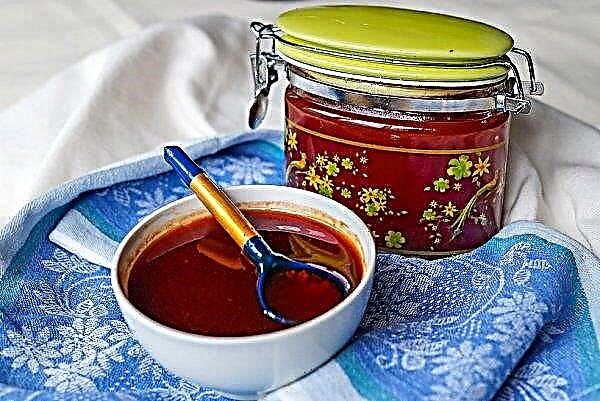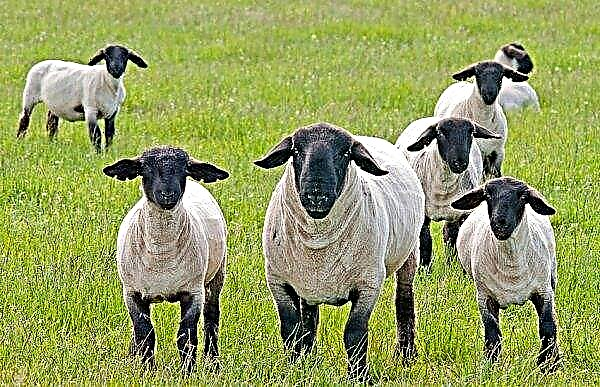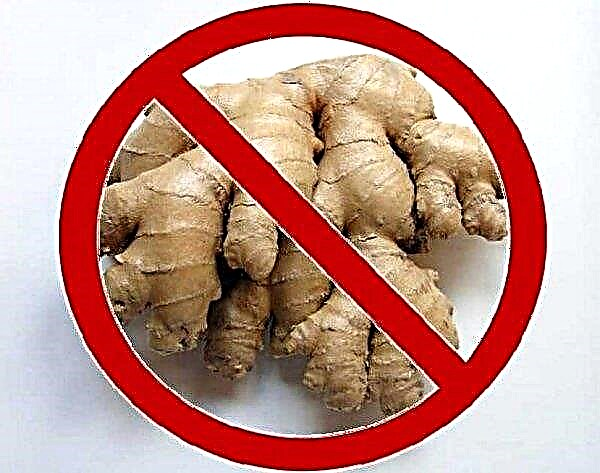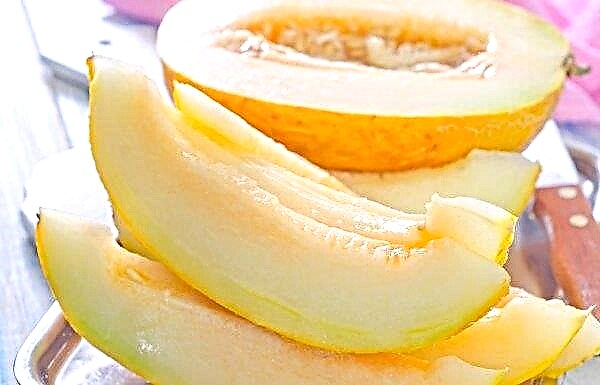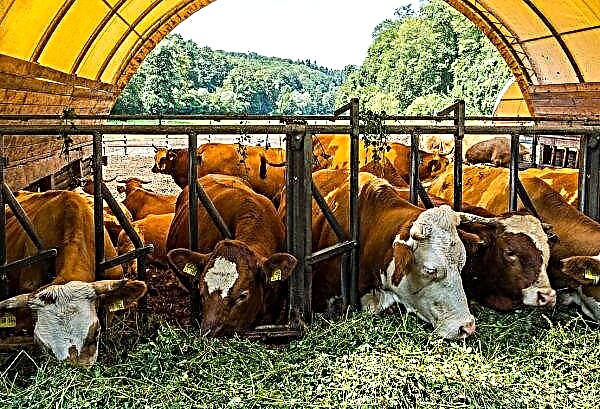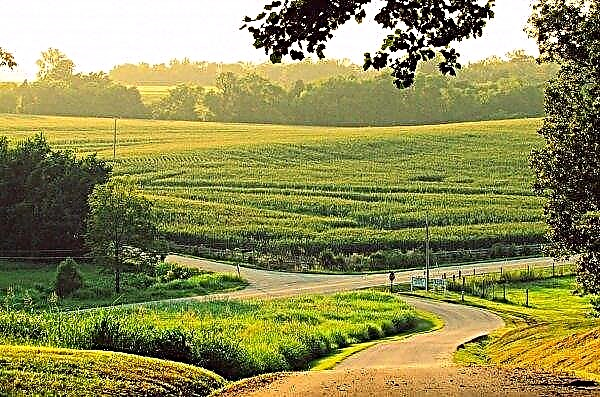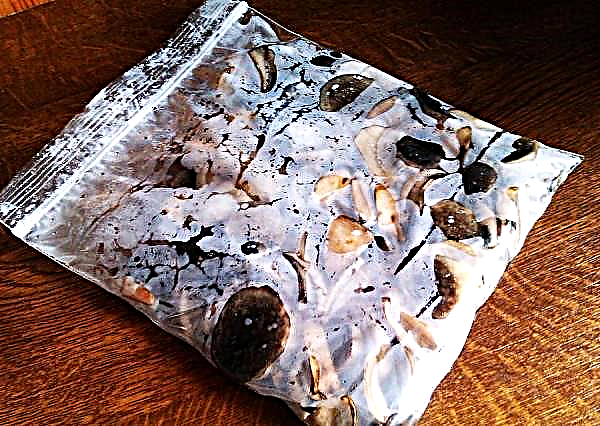Garlic has long been used in the cuisines of many countries. Its taste and smell make the dishes sharp and unique, and phytoncides emitted by the vegetable kill harmful bacteria and treat the human body. In this article we will consider how to plant winter garlic correctly, how and how to fertilize it, so that by the next summer to grow a large crop.
Dates for making autumn fertilizers
Garlic likes fertilized soils. To plant a crop before winter, the soil is fertilized during the preparation of the garden. Green green manure, rotted manure, humus, humus are embedded in the ground. If the soil was not fertilized during the autumn planting, you can fertilize the garlic by scattering humus or humus on top of the planting bed, 3-5 cm thick. Since these substances will simultaneously serve as mulch and fertilizer, this operation should be performed no earlier than mid-November, so that it is too early mulch laid on a bed did not contribute to rotting of planting material.
Did you know? U.S. scientists have proven that diallyl disulfide (a compound found in garlic) destroys the toxic bacteria Campylobacter jejuni, which cause food poisoning, are almost a hundred times more effective than antibiotics like erythromycin and ciprofloxacin.
What fertilizers to apply in the fall for garlic?
As organic fertilizers for garlic for the winter are used:
- rotted manure of pigs or cattle;
- humus;
- bird droppings;
- humus;
- siderates embedded in the soil.

For one meter of square beds, they take a bucket or 10-11 kg of home-grown, ripened compost or humus. If there is no organic fertilizer on the garden plot, a ready-made complex mineral fertilizer from the store is suitable for these purposes.
A possible combination of minerals and organics for one square meter of beds:
- 20 grams of superphosphate mixed with 5 kg of humus;
- 5 kg of compost or rotted manure mixed with 25 grams of potassium salt and 35 grams of granular double superphosphate.
Learn how to prepare a garlic bed.
In addition to the listed compounds, fertilizers are effective in the following ratios:
- One gram of potassium salt and 30 grams of granular superphosphate mixed with 0.5 buckets of humus. If clay prevails in the soil of the bed, add 10 kg (one bucket) of peat crumb to this composition.
- A ten-liter bucket of humus is mixed with a half-liter can of wood ash, two tablespoons of potassium sulfate and 1 tablespoon of double superphosphate.
- Three kilograms of rotted leaves or grass are mixed with wood ash, superphosphate and nitrophos. All minerals will need 1 tablespoon.
Organic
If the soil on the beds is sandy or clay, compost, humus, manure or other organic matter must be added. Organics are laid out on the surface of the bed and carefully digged with a shovel with a turnover of the formation. It is undesirable to leave organic fertilizers on the soil surface for a long time, since it will wash out and volatilize substances useful for plants, such as nitrogen.

Hay or dried herbs can be used as fertilizer (before starting work, make sure that they have not been treated with herbicides). Juicy, green weeds are also embedded in the ground. In the process of decomposition, they will perfectly fertilize the soil.
Important! Weed incorporation into the soil is carried out until the weed plants have ripened seeds. Sprinkled with soil, weed seeds for the next year will yield a plentiful harvest and «drowned out» all cultivated plants planted on this bed.
Humus Properties:
- Helps maintain soil structure
- improves absorption and retention of nutrients;
- nourishes bacteria;
- fixes nitrogen in the soil;
- increases soil aeration;
- retains moisture;
- helps prevent erosion.

Organic fertilizers improve every type of soil:
- Organics destroys clay soils and contributes to better moisture penetration. This increases the stability of moisture in the soil, while maintaining its structure.
- Organic matter in sandy soils helps retain moisture and retain nutrients. Soil mineralization is also increasing, which is the amount of nitrogen, potassium, sulfur, phosphorus and other nutrients secreted by soil bacteria. Organic matter contributes to the looseness of compacted soils and adds nutrients to poor soils.
- Garlic grows well in well-fertilized soil, which has enough nitrogen, phosphorus and potassium. The addition of organic fertilizers allows you to grow large garlic heads with the best spicy taste. Organic fertilizers supply most of the nutrients needed to grow large garlic.
Important! When growing garlic, you need to loosen the soil. Garlic is a root crop, so the soil in which it grows should be soft and well aerated to a depth of 25—30 cm, otherwise the garlic will already rot during the growing season.
Mineral
If necessary, add nitrogen to the soil under garlic in the fall. This is done only if hay, straw, wood chips or similar materials were used as organics, since organic substances can temporarily bind nitrogen during decomposition. After the decomposition of organic matter, nitrogen returns to the soil. When organics break down, it becomes humus.
It must be remembered that when planting garlic cloves in the autumn, you can not use a large number of fertilizers with nitrogen. This will cause a rapid growth of the green part, which will negatively affect the safety of garlic in the soil during the winter.
Nitrogen contains substances such as: urea, ammonium nitrate, calcium nitrate, sodium nitrate. To fertilize garlic, nitrogenous substances need half as much as phosphorus and potassium. In the absence of organic matter on the plot, ready-made complexes of mineral fertilizers are used.

For autumn planting of garlic, acidic soil must be moderately treated with lime, which will reduce the level of acidity. This is done as follows: dry, quicklime, finely ground lime is scattered on the surface of the bed so that the soil is slightly dusted with white powder. Also, wood ash can serve as a fighter with excessive acidity of the soil, as well as a supplier of potassium. For 1 square. m beds sprinkle about 1/3 of a ten-liter bucket of wood ash.
One of the important minerals for growing garlic is potassium. It helps to grow large garlic bulbs. If it is necessary to grow marketable products, potassium is added to the soil and large garlic heads are obtained.
Did you know? The fear of garlic is called alliumphobia; people experience fear or anxiety when they smell garlic. Symptoms of alliumphobia: sweating, a sense of doom or fear, dizziness, anxiety, fast and irregular heartbeat, a sense of irrational anger.
Use of siderates
You can also use green manure, which gardeners also call "green manure." The beds are planted with green manure immediately after harvesting the early crop preceding garlic, such as radishes, early cabbage or Peking cabbage, onions, dill.
Usually, green manure sowing occurs in early or mid-August. Before planting a siderat culture, the bed is dug up, and the soil is leveled with a rake. After that, siderat seeds are sown scattered across the surface of the soil. In order to plant small seeds in the soil, the bed is again “combed” with a rake in different directions. After sowing, green manure is watered. You can water the crops with a garden watering can or hose, the main thing is that the nozzle has a sprayer with small holes. This will prevent a powerful water stream from driving small seeds into the soil to a depth from which it will be difficult for the plant to germinate.

In warm weather (+20 ... + 25 ° C) the seeds will hatch for 7-10 days. The soil under young plants should always be slightly moist, therefore, in the absence of rain, it is necessary to water the seedlings every 3-4 days. Siderata are plants that are rapidly gaining leaf mass, so they will grow in 30–45 days and be ready for incorporation into the soil.
Siderat cultures:Did you know? Garlic contains a high concentration of volatile sulfur compounds, which, despite the benefits to human health, have a side effect in the form of halitosis.
- peas;
- oats;
- buckwheat;
- sorghum;
- clover and many others.

The rules for planting garlic in the ground
- It is better to grow varietal garlic, which allows us to hope for a good harvest and high quality products. Before planting, gardeners divide the garlic heads into wedges, after which they are planted in previously prepared furrows. If garlic cloves are not planted immediately after separation, they will be successfully stored for several days at a temperature not exceeding +4 ° C. Varietal garlic can be purchased in stores for the garden and the garden.
- For planting by separation, it is better to choose medium-sized heads (4-5 grams). To fill one square meter of a planting bed you will need from 100 to 350 grams of garlic cloves. The reason for such a wide range is, firstly, the size of the uterine garlic heads, and secondly, the interval through which the teeth will be planted. Usually, larger teeth are planted less often, while small ones are denser. At the discretion of the gardener, the distance between the garlic rows can have a width of 20 to 30 cm, and the range of gaps between the teeth stuck in the ground ranges from 5 to 10 cm.
- Depth of landing is important. Due to the need for overwintering, in the fall, garlic is planted a little deeper than in the spring. Properly planted so that the clove is located deep in the soil and was covered with at least a 5-centimeter layer of earth. Therefore, they are placed at a depth of 5-8 cm in an upright position. Planting too deep can hinder leaf growth in the future, and too small can be frozen, even despite the high resistance of this plant to low temperatures.
- When planting, a garlic clove is stuck into the soil with a wider side, there is a not yet developed root system. The pointed end of the lobule is the upper part of the future plant. If planted incorrectly, the garlic will not grow large or form incorrectly. Therefore, garlic is planted manually.
- Successful for growing garlic will be the place where previously grown: potatoes, celery or cucumbers. It is necessary to avoid planting garlic for two years in the same place or after onion, as this can lead to the development of fungal diseases. In addition to this requirement, a garlic bed requires careful weeding.
- In autumn, garlic is planted by the method of vegetative propagation (dividing the bulbs into slices or sowing seeds). Landing time is from mid-September to mid-October. Earlier or later planting reduces crop yields. Thus, the final landing date is approximately October 20. It is important that autumn planting allows you to achieve higher yields than spring. The most important drawback of garlic planted in the winter is that it is stored worse than planted in the spring.
- In the northern regions, a bed with garlic planted in autumn must be covered with mulch for the winter (straw, humus, hay or leaves). The mulch cover, like a blanket, protects the bulbs from frost. In regions with mild climates, mulching is optional, however, it can help protect garlic from freeze / thaw cycles. Also, mulch will help to retain heat in the soil of the beds longer, which will allow garlic roots to grow longer and root better.

Mulching should be carried out in late autumn, usually in November, when the cold weather is firmly established. The absence of mulch on the bed before the onset of persistent cold weather will help prevent rotting of the bulbs in warm and moist soil conditions. In humid areas where winters are mild, mulching is not recommended (especially on heavy clay soils). In spring, the mulch is removed, this contributes to the rapid thawing and heating of the soil.
Video: Proper planting of garlic in the fall
Did you know? Drinking whole or skim milk before, during, or after tasting foods high in garlic can reduce halitosis. This is because milk reduces the concentration of garlic compounds that emit the smell of sulfur.
Growing garlic is a simple process, the plant grower needs only experience and knowledge. To get a good harvest of healing vegetables, the gardener is required to properly prepare the seed and provide the garlic garden with good care: proper fertilizer, cultivation and watering.



